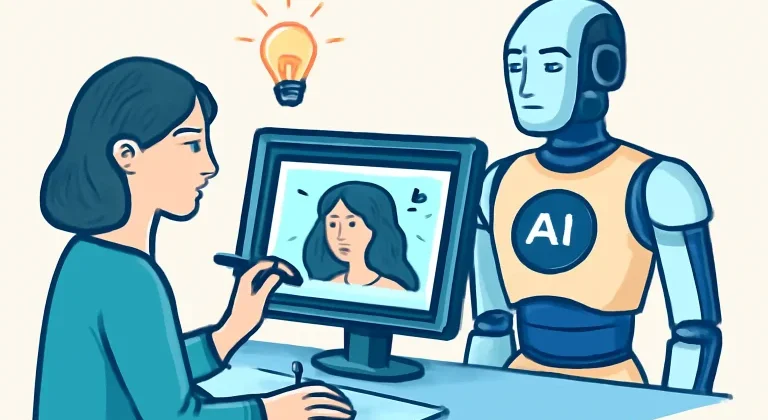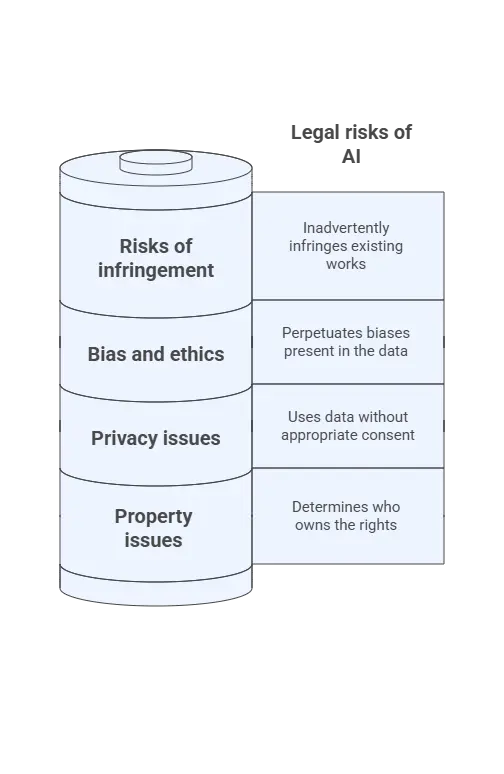Sommaire
Introduction
Artificial Intelligence (AI) has transformed creative industries by enabling the autonomous generation of content, whether in design, writing, music, or even software development. This ability of AI to produce creative works raises complex intellectual property (IP) questions. To avoid conflicts, it is essential to contractually define the rights and responsibilities of the parties involved in the creative process. This article examines the key clauses to include in contracts to secure the use of AI in these processes.
Why use AI in a creative process?
AI offers numerous advantages for creators. It enables the generation of innovative ideas by analyzing vast amounts of data, thus opening up new creative possibilities. Additionally, AI increases productivity by automating repetitive tasks, such as content generation, design adjustments, or music composition. This efficiency allows creatives to focus on more strategic aspects of their work. AI also offers the ability to personalize works based on individual client needs, which is particularly useful in sectors such as fashion, marketing, and entertainment.
Despite these benefits, the use of AI in creative processes must be accompanied by legal precautions to avoid potential risks.
Risks associated with the use of AI in a creative process
One of the main risks lies in ownership and authorship issues. Determining who holds the rights to an AI-generated work is not always clear. In many jurisdictions, intellectual property law has not been designed for AI-generated works, which can lead to conflicts over copyright ownership.
The risks associated with using AI include:
- Ownership and authorship issues
Determining who owns the rights to an AI-generated work is a grey area. The creator of the AI or the user of the AI may claim ownership, but IP laws in many jurisdictions were not designed with AI in mind.
- Data privacy issues
AI often requires large datasets to function effectively. Using data without proper consent or failing to anonymize personal data could lead to violations of privacy laws, such as GDPR in Europe.
- Bias and ethical considerations
AI systems can perpetuate biases present in training data. AI-generated works may inadvertently reinforce stereotypes or fail to meet ethical standards, potentially leading to public backlash or legal consequences.
- Infringement risks
AI-generated content may unintentionally infringe on existing works, resulting in legal conflicts over copyright or trademark violations.
Who owns the rights to AI-generated content?
In traditional creative processes, the creator of a work holds the associated rights. However, in the case of AI, the situation is more complex. The creator of the AI tool, the user, or even a third party may claim ownership of the generated work.
Generally, ownership rights should be clearly defined in a contract. It should specify whether the AI user, the AI creator, or another party owns the rights to the generated works. It is also important to indicate how these rights can be transferred or licensed to avoid ambiguity or legal conflicts.
The uncertainty surrounding the rights to AI-generated content was recently illustrated by a landmark case: Getty Images v. Stability AI, dated June 9, 2025. In this case, Getty Images one of the world’s leading providers of licensed photography filed lawsuits against Stability AI, the creator of the generative model Stable Diffusion, before both UK and US courts.
Getty accuses Stability AI of having used, without authorization, several million of its copyright-protected images to train its AI model. The large-scale use of these materials some of which were reportedly recognizable in the AI-generated outputs, with certain visuals even displaying the “Getty Images” watermark lies at the heart of a complex legal dispute, based notably on claims of copyright infringement, trademark violation, and breach of the contractual terms governing access to Getty’s databases.
However, at the beginning of the hearing on June 9, 2025, Getty Images partially revised its procedural strategy by dropping its claims of direct copyright infringement before the UK courts. The action now focuses on three grounds: trademark infringement, passing off, and secondary liability arising from the availability of a generative model trained on protected works.This strategic shift reflects the legal difficulty of qualifying AI-generated images as direct infringements when they do not identically reproduce the source images. Nevertheless, the judges established an innovative judicial framework by acknowledging that AI models even if they do not literally store the works used in their training may still fall within the scope of the Copyright, Designs and Patents Act 1988 (CDPA) when they result in outputs that harm the rights holders.
Key clauses to secure the use of AI and avoid intellectual property conflicts
To secure the use of AI in a creative process, several clauses must be included in the contract to avoid legal conflicts concerning intellectual property.
4.1. Ownership and copyright
The contract must clearly specify who owns the copyright to AI-generated works. Additionally, it is important to determine under what conditions these rights are transferred, particularly after payment for the creative work. This clarity helps avoid disputes over ownership of creations.
4.2. Use of data and confidentiality
AI tools often require access to data for learning and functioning. The contract must specify the terms of data use, including consent, confidentiality, and personal data protection. It is crucial to comply with regulations such as GDPR to avoid legal risks related to data management.
4.3. Liability and infringement risks
The contract should also clearly define the responsibilities of the parties in the event of copyright infringement or violations. It should establish the conditions under which one party would be liable for damages or legal disputes related to AI-generated works. It is also important to specify guarantees regarding non-infringement to protect the interests of all parties involved.
4.4. Ethics and mitigating bias
To prevent the risk of bias or discrimination in AI-generated works, the contract may include a clause for regular audits of the AI’s output. It is crucial that the AI systems used adhere to ethical standards and avoid reinforcing stereotypes or prejudices, which could harm the company’s reputation and lead to legal consequences.
4.5. Confidentiality and non-disclosure
Given the sensitive nature of information related to AI and the generated works, it is essential to include confidentiality clauses in the contract. These clauses will protect sensitive information exchanged between the parties and ensure that no confidential data is disclosed without prior authorization.
Conclusion
Using AI in creative processes offers considerable opportunities but requires rigorous legal management to avoid intellectual property conflicts. By including necessary clauses regarding ownership, data use, liability, ethics, and confidentiality, parties can ensure that AI use is secure, transparent, and legally sound.
Dreyfus Law firm assists its clients in managing complex intellectual property cases, offering personalized advice and comprehensive operational support for the complete protection of intellectual property.
Dreyfus Law firm is partnered with a global network of lawyers specializing in intellectual property.
Nathalie Dreyfus with the assistance of the entire Dreyfus team.
FAQ
1. Who owns the rights to AI-generated content?
Ownership typically depends on the terms of the contract, which may assign rights to the AI user, the AI creator, or another party.
2. What are the risks associated with using AI in creative processes?
Risks include ownership conflicts, data privacy violations, ethical concerns regarding AI biases, and potential IP infringements.
3. How can I avoid property conflicts related to AI?
It is important to clearly define ownership of copyright in the contract and ensure that the AI does not generate content that infringes existing rights.
4. What are the legal implications of using AI in creative processes?
Legal implications mainly concern intellectual property, data protection, liability for AI-generated results, and ethical considerations.
5. Can AI create works protected by copyright?
In many jurisdictions, works created by AI are not automatically protected by copyright unless a human author is involved in the creative process.


